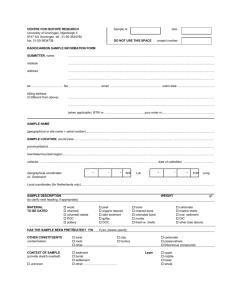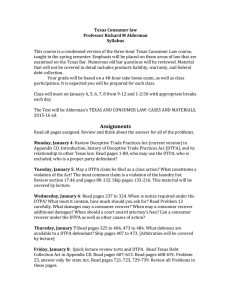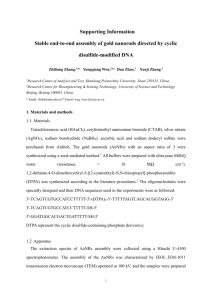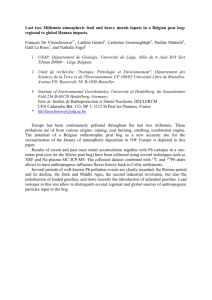What’s in Your Media? Analysis of media components for micronutrient content
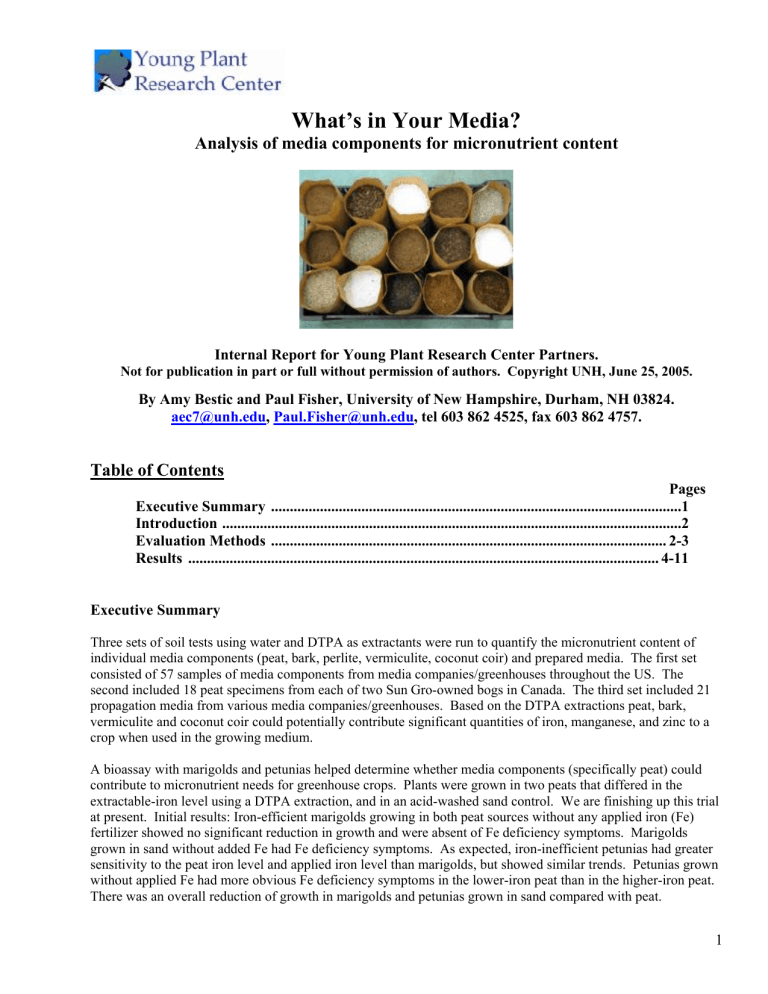
What’s in Your Media?
Analysis of media components for micronutrient content
Internal Report for Young Plant Research Center Partners.
Not for publication in part or full without permission of authors. Copyright UNH, June 25, 2005.
By Amy Bestic and Paul Fisher, University of New Hampshire, Durham, NH 03824.
aec7@unh.edu
,
Paul.Fisher@unh.edu
, tel 603 862 4525, fax 603 862 4757.
Table of Contents
Pages
Executive Summary .............................................................................................................1
Introduction ..........................................................................................................................2
Evaluation Methods ......................................................................................................... 2-3
Results ............................................................................................................................. 4-11
Executive Summary
Three sets of soil tests using water and DTPA as extractants were run to quantify the micronutrient content of individual media components (peat, bark, perlite, vermiculite, coconut coir) and prepared media. The first set consisted of 57 samples of media components from media companies/greenhouses throughout the US. The second included 18 peat specimens from each of two Sun Gro-owned bogs in Canada. The third set included 21 propagation media from various media companies/greenhouses. Based on the DTPA extractions peat, bark, vermiculite and coconut coir could potentially contribute significant quantities of iron, manganese, and zinc to a crop when used in the growing medium.
A bioassay with marigolds and petunias helped determine whether media components (specifically peat) could contribute to micronutrient needs for greenhouse crops. Plants were grown in two peats that differed in the extractable-iron level using a DTPA extraction, and in an acid-washed sand control. We are finishing up this trial at present. Initial results: Iron-efficient marigolds growing in both peat sources without any applied iron (Fe) fertilizer showed no significant reduction in growth and were absent of Fe deficiency symptoms. Marigolds grown in sand without added Fe had Fe deficiency symptoms. As expected, iron-inefficient petunias had greater sensitivity to the peat iron level and applied iron level than marigolds, but showed similar trends. Petunias grown without applied Fe had more obvious Fe deficiency symptoms in the lower-iron peat than in the higher-iron peat.
There was an overall reduction of growth in marigolds and petunias grown in sand compared with peat.
1
Introduction
Micronutrients can be supplied in the form of sulfates, oxides, and chelates (HEDTA, EDTA, DTPA and
EDDHA). However, there are several other potential sources of micronutrients that have not been extensively studied that may contribute to a micronutrient budget for growing bedding plants. Some of these sources can be considered “contaminant” (usually uncontrolled) sources and include media components (peat, bark, perlite, vermiculite, coconut coir), irrigation water, pesticides and lime.
UNH experiments on marigolds and geraniums (iron-efficient species) have found iron (Fe)/ manganese (Mn) toxicity symptoms when grown at a low pH (4.1-4.9) with no Fe supplied in the nutrient solution (Wik, 2003).
The medium components, a fungicide drench and both a preplant and flowable lime drench all potentially contributed Fe and Mn to the plants that caused the toxicity. These contributors are normally not considered when formulating the fertilizer solution added to a crop. This survey of media components will shed some light on the quantities of micronutrients lurking in soilless media.
Several testing methods have been developed for finding the nutrient content of soilless media—saturated media extract
(SME), 2:1 by volume and Pour Thru. SME is the most widely used method for testing nutrient content of media. It uses distilled water as the extractant to determine the micronutrients available in the media solution and gives a more reliable measure of the available nutrients (Warncke, 1986; Warncke,
1995). However, Berghage et al.
(1987) have found that a modified SME method that uses DTPA acid at 0.005M resulted in a more accurate correlation with the actual reserves of micronutrients in the sample. The DTPA acid is a stronger extractant than water and helps to remove more micronutrients from the media exchange sites (Berghage et al.
1987).
Objectives:
1.
Quantify the micronutrient content of a survey of peat, bark, perlite, vermiculite, and coconut coir samples.
2.
Determine whether marigolds and petunias grown in peat samples and sand (control) can mine the micronutrients found in the peat as a nutrient source.
3.
Develop a budget of micronutrient supply and uptake (Fe and Mn specifically) for greenhouse crops.
4.
Correlate the tissue content of the plants with the extractable nutrients found with the DTPA extractions.
(note: the tissue data is not yet collected).
Evaluation Methods
Quantifying Micronutrients
Three sources of growing media were evaluated:
(a) Media Component Survey: Various media components (peat, bark, perlite, vermiculite, and coconut coir) were collected from media companies/greenhouses throughout the US for a total of 57 samples:
Peat (12)
Bark (15)
Perlite (10) Coconut coir (6)
Vermiculite (14)
2
(b) In-depth Peat Bog Samples: 18 peat specimens from each of two Sun Gro-owned bogs in Canada (36 samples total).
(c) Propagation Media: 21 propagation media from various media and greenhouse companies.
The 114 samples from the three trials were tested using SME method with triple-distilled water and 0.005M
DTPA as extractants. Three replicates of each sample with each extractant type were run for a total of 648 extractions. Dry weight and mL of extractant were recorded for each extraction. EC and pH readings for each extraction were also taken followed by further testing of micronutrient contents using ICP analysis.
Bioassay Experiment
Two of the tested peat samples (Blackmore and Sun Gro) that varied in their DTPA-extractable Fe levels (Table 1, page 9) were used along with sand (as a control) to grow both marigolds (ironefficient) and petunias (iron-inefficient) for a micronutrient bioassay experiment. Our goals were: (1) to quantify whether there was a difference in uptake of iron and manganese from different peat sources, (2) whether any difference in tissue iron or manganese correlated with DTPA or water extractions of the peat, and (3) the relative contribution of the peat and fertilizer sources of micronutrients towards plant uptake.
There were four nutrient solutions used during the trial (listed below as well as ppm of each nutrient):
Complete (all nutrients)
Complete Fe
Complete Mn
Complete minus Fe & Mn
The complete nutrient solution included: NO
3
(181.1 ppm), NH
4
(13.7 ppm), P
(30.4 ppm), K (193.9 ppm), Ca (159.7 ppm), Mg (48.8 ppm), S (64.3 ppm),
Fe (1 ppm), Mn (0.5 ppm), Zn (0.5 ppm), Cu (0.25 ppm), B (0.25 ppm), Mo (0.2 ppm)
The plants were direct sown into each pot containing one of the three media types. After germination, each pot was irrigated with 100 mL of one of the four nutrient solutions. Plants were grown for 5 weeks. Final physical measurements including plant height, leaf length, SPAD measurement, fresh and dry weights were taken. The dry tissue will be analyzed for the Fe and Mn content (trial is not yet completed).
Literature cited
Berghage, R.D., D.M. Krauskopf, D.D. Warncke, and I. Widders. 1987. Micronutrient Testing of Plant Growth Media
Extractant, Identification and Evaluation. Commun. In Soil Sci. Plant Anal . 18(9): 1089-1109.
Warncke, D.D. 1986. Analyzing Greenhouse Growth Media by the Saturation Extraction Method. HortScience 21(2): 223-
225.
Warncke, D.D. 1995. Recommended Test Procedures for Greenhouse Growth Media . Ch. 11, pp76-82. In: Recommended
Soil Testing Procedures 2 nd
Edition. University of Delaware, Newark, Delaware.
Wik, R.M. 2003. The Effect of Iron Form, Substrate-pH, and Iron Efficiency on Plant Nutritional Status . M. S. Thesis.
University of New Hampshire. Durham, New Hampshire.
3
Results
(a) Media Component Survey
Data set: 57 samples = peat (12) , perlite (10), coconut coir (6), bark (15), vermiculite (14)
Figure 1.
Average (median) values of micronutrients for media components tested using SME with water (top) and DTPA (bottom). Error bars are maximum and minimum values for each nutrient. max =
2.0
Micronutrient Content (median) of Media Components (SME
Water)
10.41
7.79
5.48
1.5
1.70
1.31
Peat
Bark
Perlite
Vermiculite
Coir
1.0
0.5
0.0
0.33
0.55
0.08
0.43
0.12
0.01
0.02
0.08
0.10
0.29
0.03
0.03
0.43
0.02
0.02
0.02
0.02
0.03
0.04
0.11
0.01
0.01
0.04
0.01
0.01
0.01
0.01
0.01
Fe Mn B Cu
Micronutrient
Zn Mo
Micronutrient Content (median) of Media Components (SME
DTPA) max =
70
136.6 101.9
117.9
62.06
60
50 48.38
Peat
Bark
Perlite
Vermiculite
Coir
40
39.57
37.87
30
20
13.15
10
4.90
0.44
0.33
8.98
6.58
0.35
0.61
0.06
0.26
0.64
0.06
0.31
0.02
0.87
0.47
1.25
6.61
0.06
0.54
2.52
0.02
0.05
0.01
0.04
0.01
0
Fe Mn B Cu Zn Mo
Micronutrient
Based on the water extractions, bark and vermiculite yielded higher levels of Fe than the other components. In addition the Mn level was highest in bark.
The DTPA extractions resulted in significantly greater nutrient quantities in all media components, especially for Fe and Mn. Peat and bark yielded higher levels of Fe than the other components. Bark continued to have high level of Mn and Zn.
Peat, bark, vermiculite and coconut coir could potentially contribute significant quantities of iron, manganese, and zinc to a crop.
4
(a) Media Component Survey continued..
Figure 2. EC and pH median values for media components tested using SME with water and DTPA. Error bars are maximum and minimum values for each component.
EC median values for media components pH median values for media components
9
4.0
3.5
8
DTPA
Water
DTPA
Water
7
6.87
6.65
3.0
2.5
2.64
2.13
6
5 4.56
5.08
5.38
5.00
5.69
2.0
1.5
1.09
4
3.03
3.44
3.03
3
1.0
0.65
0.33
0.68
0.5
0.50
0.05
0.42
0.11
2
1
0.0
0
Peat Bark Perlite Vermiculite Coir
Peat Bark Perlite Vermiculite Coir
Media components
Media components
Coconut coir had higher EC values than the other components.
Peat and perlite had the lowest pH values with the DTPA extraction. Peat tends to be acidic and also had a low pH with a water extraction. Perlite has a low cation exchange capacity on a per volume basis and fairly neutral pH based on a water extraction, and pH could therefore be easily driven down by the acidic
DTPA solution.
(b) In-depth Peat Bog Samples
Data set: 36 samples = 18 peat specimens from each of two Sun Gro-owned bogs in Canada
Figure 3.
Average (median) values of micronutrients for Sun Gro peat samples tested using SME with water and
DTPA. Error bars are maximum and minimum values for each nutrient.
4.0
Micronutrient Content (median) of Sungro Peat Samples
*
3.5
3.0
2.5
2.0
DTPA
Water
1.5
1.22
1.20
1.15
1.0
0.62
0.42
0.5
0.13
0.05
0.03
0.08
0.03
0.02
0.0
*
Median=72.25
Maximum=85.23
Minimum=50.88
Fe Mn B Cu
Micronutrient
Zn Mo
Based on the DTPA extractions, peat could potentially contribute significant quantities of Fe, and to a lesser extent Mn, B and Zn to a plant if roots are able to mine these nutrients from the medium.
5
(b) In-depth Peat Bog Samples continued..
Figure 4. EC and pH median values for Sun Gro peat samples tested using SME with water and DTPA. Error bars are maximum and minimum values for each sample.
EC and pH median values for Sungro Peat
4
3
2
DTPA
Water
3.44
3.61
1
0.61
0.44
0
EC pH
As expected, EC was low and pH was acidic for the peat samples.
Figure 5.
Average (mean) values of Fe (top) and Mn (bottom) content of Sun Gro peat samples tested using SME with water and DTPA. The first 18 samples on the left side of each graph are from Bog 1 with increasing degree of decomposition from left to right. The second 18 samples on the right side of each graph are from Bog 2 with increasing degree of decomposition from left to right.
Iron content of peat
50
40
30
20
90
80
70
60
DTPA
Water
5
4
3
2
9
8
7
6
10 1
0 0
Increasing Decomposition → ▌ Increasing Decomposition →
Bog 1 samples Bog 2 samples
Iron content of water extractions ranged from 0.5-2.4 ppm and from 50.9-85.2 ppm for DTPA extractions.
There were no significant differences between the two bogs based on iron content with the two extractants.
Degree of peat decomposition appeared to have no effect on Fe content.
6
(b) In-depth Peat Bog Samples continued..
Manganese content of peat
3.5
3.0
2.5
DTPA
Water
2.0
1.5
1.0
2.0
1.5
1.0
3.5
3.0
2.5
0.5
0.5
0.0
0.0
Increasing Decomposition → ▌ Increasing Decomposition
Bog 1 samples Bog 2 samples
→
Manganese content of water extractions ranged from 0.1-2.5 ppm and from 0.3-2.9 ppm for DTPA extractions.
There were no significant differences between the two bogs based on manganese content with the two extractants.
Degree of peat decomposition appeared to have no affect on Mn content.
(c) Propagation Media
Data set:
21 samples of propagation media from various media companies/greenhouses
Figure 6 . Average (median) values of macronutrients (top) and micronutrients (bottom) for propagation media.
Error bars are maximum and minimum values for each nutrient.
Macronutrients
Average (median) values for propagation media
450
400
350
300
250
200
150
100
50
0
6.40
6.25
216.52
158.02
115.63
87.37
DTPA
Water
NO3-N
(ppm)
NH4-N
(ppm)
P (ppm) K (ppm) Ca
(ppm)
Nutrient
Mg
(ppm)
SO4-S
(ppm)
Na
(ppm)
Si (ppm)
7
(c) Propagation Media continued..
Micronutrients
Average (median) values for propagation media
Max = 102.9
14
12
10
8
6
4
2
0
24
22
20
18
16
19.02
0.42
6.24
0.39
0.41
0.29
0.28
0.02
1.93
0.17
DTPA
Water
0.04
0.02
1.87
0.26
Fe (ppm) Mn (ppm) B (ppm) Cu (ppm) Zn (ppm) Mo (ppm) Al (ppm)
Nutrient
Data were consistent with Berghage results in that macronutrient and B levels were similar with both extraction methods.
As expected, extractable Fe, Mn, Zn, and Al levels were much higher with DTPA.
Median Fe was much lower than the values found for media components in trials (a) and (b).
Figure 7.
Mean, median, minimum and maximum values of EC and pH for the propagation media.
Average (median) values for EC and pH of propagation media
7.00
6.00
5.00
4.00
3.00
2.00
1.00
0.00
DTPA
Water
1.81
1.58
5.07
5.31
EC pH
Measurement
Media-EC values were in the normal range (1.2 to 2.5) for propagation media using a water extraction. The media-pH levels tended to be lower than normal (5.4 to 6.4). The low pH was probably because the lime had not fully reacted in some media, although we did keep media moist for 2 weeks before extracting nutrients.
8
Bioassay Experiment
Table 1. Average (mean) values of macronutrients and micronutrients (ppm) for Blackmore and Sun Gro peat extracted with water and DTPA by three commercial laboratories. Five replicates of each peat type with each extractant were tested for a total of 20 extractions. Each of the three labs tested the same 20 sample extractions to help determine the variability between laboratories.
NO
3
NH
4
1 Blackmore Water 2.44 7.99 2.09
3.84
3.18
8.94
9.75 0.04 0.59 0.12 0.00 0.03 0.00 0.53 17.50 23.02
Blackmore DTPA 0.00 9.19 1.95
4.59
7.06 21.56
7.98 0.03 57.40 0.40 0.01 1.00 0.00 5.88 20.00 19.50
Sun Gro Water
Sun Gro DTPA
0.00 19.90 5.56 12.58 39.48 23.18 60.34 0.08 0.85 1.04 0.00 0.06 0.00 1.38 15.10
0.00 18.92 5.12 12.08 54.24 30.46 45.22 0.06 93.40 1.56 0.02 1.37 0.00 7.07 13.42
4.45
0.82
2 Blackmore Water 1.24 2.28 1.11
5.04 21.50 11.81 12.22 0.08 3.74 0.21 0.02 0.10 0.01 0.87 23.60
Blackmore DTPA 0.46 2.92 0.95
7.45 54.83 23.19
8.50 0.20 58.58 0.45 0.04 1.08 0.02 5.89 28.72
Sun Gro Water
Sun Gro DTPA
1.34 12.98 4.55 14.02 65.26 23.25 67.17 0.12 0.71 0.90 0.01 0.07 0.01 1.12 23.01
0.20 14.42 4.27 14.95 88.16 31.17 49.43 0.31 94.25 1.54 0.05 1.43 0.02 6.43 21.54
3 Blackmore Water 3.40 14.20 1.93
4.59
3.34
9.15
9.85 0.06 1.45 0.14 0.00 0.05 0.00 0.45 14.94
Blackmore DTPA 0.40 14.00 1.66
6.19
6.83 22.27
7.75 0.01 70.44 0.44 0.02 1.11 0.00 5.49 21.00
Sun Gro Water
Sun Gro DTPA
2.40 26.60 5.57 11.85 39.88 23.61 63.38 0.09 0.90 1.16 0.00 0.07 0.00 1.05 12.97
2.40 21.80 4.69 12.75 53.73 30.63 45.06 0.02 124.56 1.76 0.04 1.52 0.00 6.38 15.76
ND
ND
ND
ND
ND 5.79
ND 4.76
ND 11.21
ND 9.97
ND
ND
ND
ND
ND
ND
ND
ND
According to the DTPA extractions from all labs, Blackmore peat had lower extractable Fe than Sun Gro.
9
Figure 8.
Two of the tested peat samples (Blackmore-BM and Sun Gro SG) that varied in their DTPAextractable Fe levels were used along with sand (as a control) to grow both marigolds (top) and petunias
(bottom) for a micronutrient bioassay experiment. After germination, each pot was irrigated with 100 mL of one of the four nutrient solutions (listed below). Plants were grown for 5 weeks. The dry tissue will be analyzed for the Fe and Mn content (trial is not yet completed).
Fertilizer Treatments:
Complete (-)Fe (-)Mn (-)Fe & Mn
Media Type:
BM peat
(lower extractable
Fe)
SG peat
(higher extractable
Fe)
Sand
Media Type:
BM peat
(lower extractable
Fe)
SG peat
(higher extractable
Fe)
Sand
Fertilizer Treatments:
Complete (-)Fe (-)Mn (-)Fe & Mn
10
Plant growth for both species was considerably decreased in the sand versus the two peat types across all nutrient treatments.
Iron deficiency was prominent in the petunias grown in sand in the (-) Fe and (-) Fe & Mn treatments and started to show in the Blackmore (lower-iron) peat in the (-) Fe and (-) Fe & Mn treatments after 5 weeks.
The Blackmore (lower-iron) peat according to the DTPA extractions also contained lower extractable iron than the Sun Gro (higher-iron) peat.
Iron deficiency symptoms were present on the marigolds grown in sand in the (-) Fe and (-) Fe & Mn treatments. The Marigolds grown in peat showed no reduction in growth or deficiency symptoms across the nutrient treatments.
Table 2.
A nutrient budget for Fe and Mn provided by medium and lime compared with 1 mg Fe·L
-1
supplied from Fe-EDTA.
Iron sources in the experiment
(1) Solutions
Deionized water
EDTA fertilizer solution
(2) Peat
SME DTPA extraction
SME deionized water extraction
(3) Lime amendments
Lime (dolomitic lime)
Fe
0.00
1.00 mg·L
-1
Mn
0.00
0.50 mg Fe or Mn/pot
Fe
Notes
Mn
0.00
1.40
0.00
0.70
100 mL/pot, 14 irrigations = 1400 mL/pot
1 mg.L
-1
Fe, 100 mL/pot, 14 irrigations (includes deionized water) mg.L
-1 mg Fe or Mn/pot
Fe Mn Fe Mn
71.01
1.25
Fe
µg · g
-1
473.44
1.32
0.83
Mn
41.42
21.95 0.41
450 mL media/pot, 826 mL extractant/liter media
0.39 0.26
450 mL media/pot, 816 mL extractant/liter media mg Fe or Mn/pot
Fe Mn
0.26 0.02
Fe Mn
Applied at 8 lb/yd
3
= 4.8 g/L, 450 mL/pot = 2.16 g/pot
TOTAL load of Fe, Mn 23.61 1.13
1 mg.L
-1
solution, including lime, and DTPA-extraction from peat
% of total load from fertilizer solution:
6% 62%
The analysis assumes that the plant is growing in a peat medium amended with lime.
Peat extractions are averaged from the experiment (b) with 36 peat samples from two bogs.
The dolomitic lime digestion is based on National Lime and Stone dolomitic pulverized lime.
Our initial view is that the DTPA extraction overestimates extractable Fe, and the water extraction may underestimate extractable Fe. DTPA may therefore be a stronger extractant and water may be a weaker extractant than plant roots. We know from the bioassay experiment and published research that the
“extractant power” or “iron efficiency” of plant species definitely varies. DTPA also lowers pH of the soil solution compared with water, thereby increasing micronutrient solubility, and this may also be a reason for the higher extracted micronutrient levels compared with water and plant uptake, in addition to the chelating action of DTPA. Our current view is that DTPA is a more useful extractant than water, but more research is needed to interpret extracted soil test levels versus plant available nutrients.






